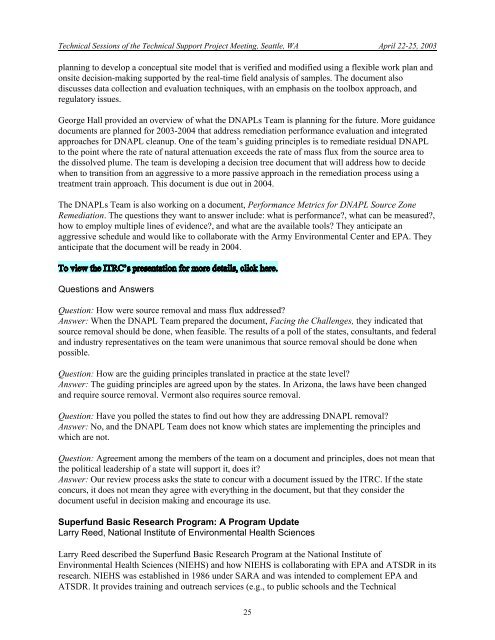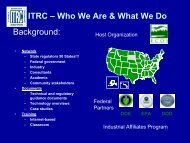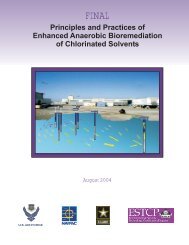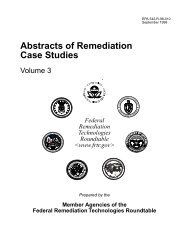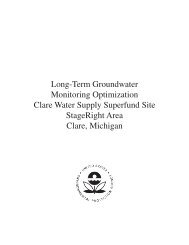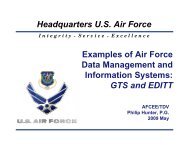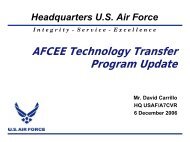Technical Sessions - Environmental Management Support, Inc.
Technical Sessions - Environmental Management Support, Inc.
Technical Sessions - Environmental Management Support, Inc.
You also want an ePaper? Increase the reach of your titles
YUMPU automatically turns print PDFs into web optimized ePapers that Google loves.
<strong>Technical</strong> <strong>Sessions</strong> of the <strong>Technical</strong> <strong>Support</strong> Project Meeting, Seattle, WA April 22-25, 2003<br />
planning to develop a conceptual site model that is verified and modified using a flexible work plan and<br />
onsite decision-making supported by the real-time field analysis of samples. The document also<br />
discusses data collection and evaluation techniques, with an emphasis on the toolbox approach, and<br />
regulatory issues.<br />
George Hall provided an overview of what the DNAPLs Team is planning for the future. More guidance<br />
documents are planned for 2003-2004 that address remediation performance evaluation and integrated<br />
approaches for DNAPL cleanup. One of the team’s guiding principles is to remediate residual DNAPL<br />
to the point where the rate of natural attenuation exceeds the rate of mass flux from the source area to<br />
the dissolved plume. The team is developing a decision tree document that will address how to decide<br />
when to transition from an aggressive to a more passive approach in the remediation process using a<br />
treatment train approach. This document is due out in 2004.<br />
The DNAPLs Team is also working on a document, Performance Metrics for DNAPL Source Zone<br />
Remediation. The questions they want to answer include: what is performance?, what can be measured?,<br />
how to employ multiple lines of evidence?, and what are the available tools? They anticipate an<br />
aggressive schedule and would like to collaborate with the Army <strong>Environmental</strong> Center and EPA. They<br />
anticipate that the document will be ready in 2004.<br />
Questions and Answers<br />
Question: How were source removal and mass flux addressed?<br />
Answer: When the DNAPL Team prepared the document, Facing the Challenges, they indicated that<br />
source removal should be done, when feasible. The results of a poll of the states, consultants, and federal<br />
and industry representatives on the team were unanimous that source removal should be done when<br />
possible.<br />
Question: How are the guiding principles translated in practice at the state level?<br />
Answer: The guiding principles are agreed upon by the states. In Arizona, the laws have been changed<br />
and require source removal. Vermont also requires source removal.<br />
Question: Have you polled the states to find out how they are addressing DNAPL removal?<br />
Answer: No, and the DNAPL Team does not know which states are implementing the principles and<br />
which are not.<br />
Question: Agreement among the members of the team on a document and principles, does not mean that<br />
the political leadership of a state will support it, does it?<br />
Answer: Our review process asks the state to concur with a document issued by the ITRC. If the state<br />
concurs, it does not mean they agree with everything in the document, but that they consider the<br />
document useful in decision making and encourage its use.<br />
Superfund Basic Research Program: A Program Update<br />
Larry Reed, National Institute of <strong>Environmental</strong> Health Sciences<br />
Larry Reed described the Superfund Basic Research Program at the National Institute of<br />
<strong>Environmental</strong> Health Sciences (NIEHS) and how NIEHS is collaborating with EPA and ATSDR in its<br />
research. NIEHS was established in 1986 under SARA and was intended to complement EPA and<br />
ATSDR. It provides training and outreach services (e.g., to public schools and the <strong>Technical</strong><br />
25


